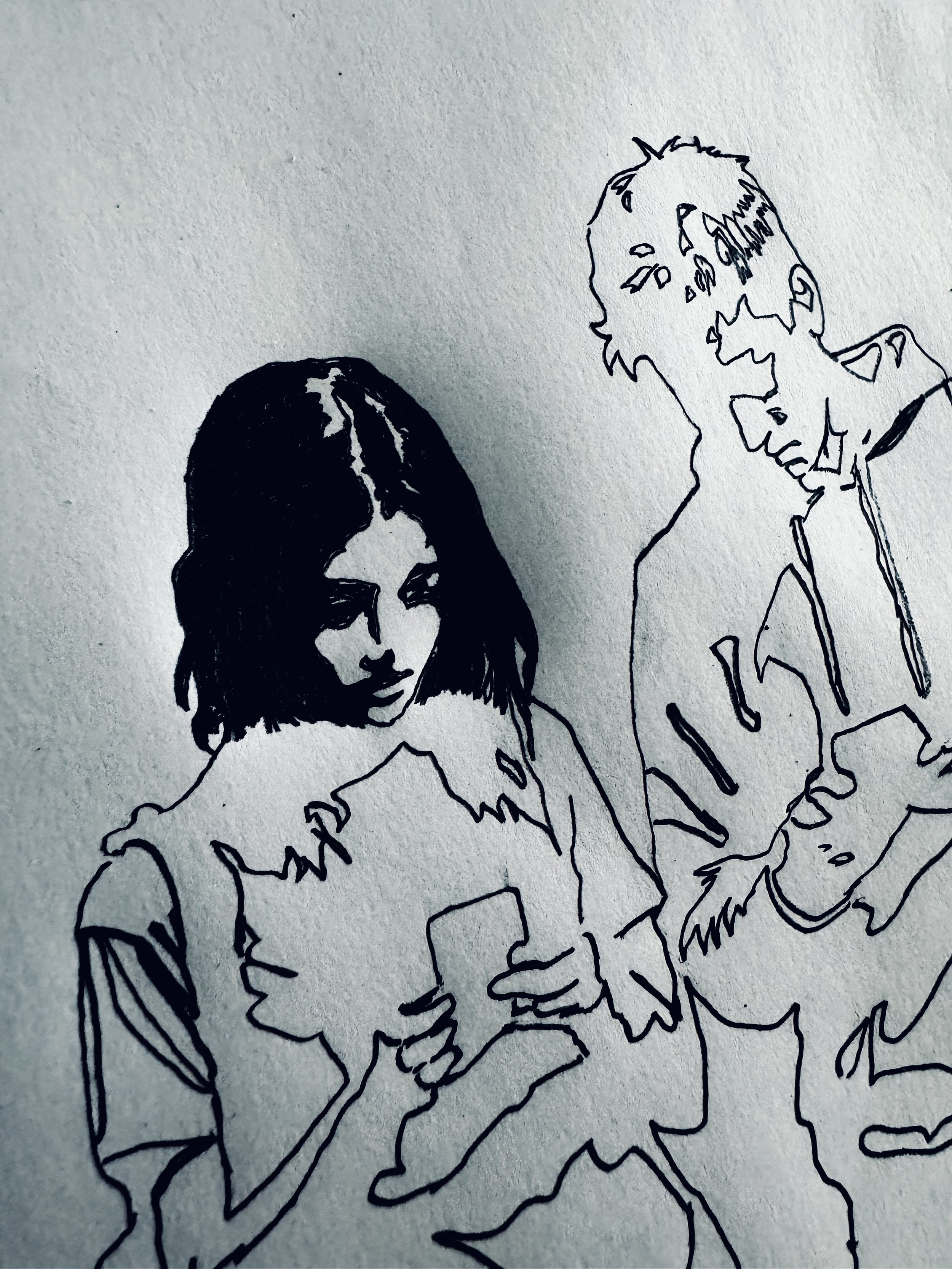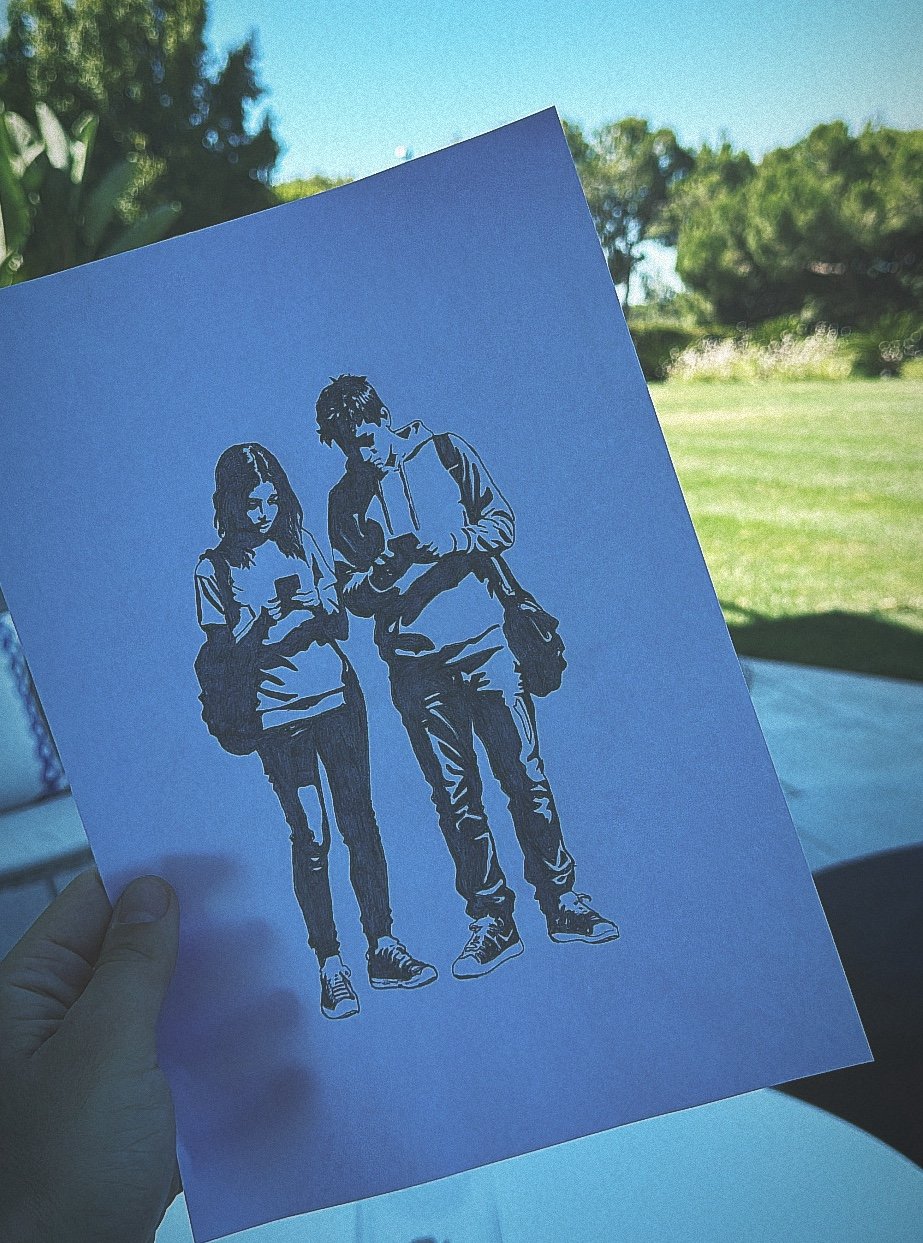Luces y Sombras
Graphite and Ink on paper (studio sketch)
Executed 29 May 2024, Portugal
Luces y Sombras is a decisive studio sketch in Miguel Fernández’s development, an image that consolidates a sequence of earlier bocetos and clarifies the graphic grammar that now defines his work. Observed on a London afternoon, two teenagers drift home from school with heads bowed, backs slightly rounded, and thumbs fixed to their phones. They stand together, yet their attention makes them strangers. Fernández captures this ordinary scene with rigorous economy: blocks of ink, clean negative space, and a choreography of highlights that read as “light,” while the engulfing fields of black register as “shadow.”
The title operates on two levels. Formally, it describes the drawing’s sharp chiaroscuro, the crisp alternation of illuminated passages (cheeks, knees, the edge of a sneaker) against weighty silhouettes. Conceptually, it names the condition of adolescence in the age of feeds and infinite scrolls: screens promise illumination while casting lengthy shadows, of isolation, anxiety, and a susceptibility to manipulation. Fernández’s choice of Spanish, Luces y Sombras, adds a lyrical distance, framing a global predicament with the gravity of a moral fable.
Compositionally, the pair functions like a duet in counterpoint. The left figure’s compact stance meets the right figure’s longer stride; one sleeve bunched, the other smooth; two backpacks anchoring the bodies to everyday life even as their gazes retreat into private glow. The drawing’s power lies in what Fernández withholds. There is no street, no sky, no school gate, only an expanse of untouched paper. By subtracting environment, he makes distraction itself the environment. The blank ground becomes the social world these teenagers no longer register.
This sketch “perfects” a chain of earlier studies: the single-figure Screen Walk and preparatory works that trialled heavier lines, sculptural shadows, and the translation of drawings into stencils for the street. Here, Fernández stabilises the vocabulary; broad, confident blacks; economical modelling; decisive edges, ready for enlargement, cutting, and deployment as public interventions. The piece thus sits at a hinge between studio and city, between observation and address.
The work is also biographical in its urgency. A former teacher and educator, Fernández has watched traditional forms of play, curiosity and peer interaction give way to the trance of the timeline. Luces y Sombras distils that observation without polemic. Nothing sensational occurs; the drawing’s very quietness is accusatory. It asks how a generation learns empathy, imagination or dissent when their first encounter with the world is mediated, gamified and often engineered for outrage or conformity. In this sense, “light” is the flicker of the device; “shadow” names the broader eclipse; of presence, of attention, of mental well-being, and the real risk of radicalisation by the invisible logics of the feed.
As an object, the sketch is deliberately lean. The mark-making feels both rehearsed and alive, the kind of line that knows where it’s going. Highlights are not blended but cut; shadows do not describe every fold, only the ones that hold meaning. This restraint gives the teenagers a sculptural density while preserving the speed of drawing; it is the look of an artist refining an alphabet he intends to speak at scale.
Significance
Luces y Sombras crystallises Fernández’s mission: to confront, with clarity and empathy, the costs of screen-saturated youth culture. It formalizes his mature, high-contrast idiom and sets the stage for the two-figure street works that would follow. More than a preparatory sheet, it is a moral image for our time, an elegant study whose “lights and shadows” are not merely optical effects but the psychic weather of adolescence under the rule of the algorithm.



